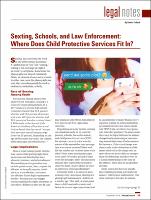Please use this identifier to cite or link to this item:
https://hdl.handle.net/20.500.12202/4728Full metadata record
| DC Field | Value | Language |
|---|---|---|
| dc.contributor.author | Pollack, Daniel | - |
| dc.date.accessioned | 2019-09-25T21:35:49Z | - |
| dc.date.available | 2019-09-25T21:35:49Z | - |
| dc.date.issued | 2018-12 | - |
| dc.identifier.citation | Pollack, Daniel (December 2018). Sexting, Schools, and Law Enforcement: Where Does Child Protective Services Fit In? Policy & Practice 76(6): 25. | en_US |
| dc.identifier.issn | 1942-6828 | - |
| dc.identifier.uri | https://search.proquest.com/docview/2160691069?accountid=15178 | en_US |
| dc.identifier.uri | https://hdl.handle.net/20.500.12202/4728 | - |
| dc.description | Legal notes | en_US |
| dc.description.abstract | In a 2017 study of a private high school, researchers found that 15.8 percent of males and 13.6 percent of females sent sexts; 40.5 percent of males and 30.6 percent of females received them.1 A 2016 study in the Journal of the American Academy of Psychiatry and the Law found that the rate of "minors who have sent sexual images range from 4 to 25 percent, depending on the age of the youths surveyed, the content of the messages and other factors. "2 Legal Implications From a legal vantage point, sexting may violate child pornography laws, possession and distribution laws, obscenity statutes, and other offenses.3 The resulting severe penalties may include prison terms, fines, require the offender to formally register indefinitely as a sex offender, and cause the offender future high employment hurdles. A minor who violates subsection 1: (a) For the first violation: (1) Is a child in need of supervision, as that term is used in title 5 of NRS, and is not a delinquent child; and (2) Is not considered a sex offender or juvenile sex offender and is not subject to registration or community notification as a juvenile sex offender pursuant to title 5 of NRS, or as a sex offender pursuant to NRS 179D.010 to 179D.550, inclusive. (b) For the second or a subsequent violation: (1) Commits a delinquent act, and the court may order the detention of the minor in the same manner as if the minor had committed an act that would have been a misdemeanor if committed by an adult; and (2) Is not considered a sex offender or juvenile sex offender and is not subject to registration or community notification as a juvenile sex offender pursuant to title 5 of NRS, or as a sex offender pursuant to NRS 179D.010 to 179D.550, inclusive. 5. A minor who violates subsection 2: (a) Commits a delinquent act, and the court may order the detention of the minor in the same manner as if the minor had committed an act that would have been a misdemeanor if committed by an adult; and (b) Is not considered a sex offender or juvenile sex offender and is not subject to registration or community notification as a juvenile sex offender pursuant to title 5 of NRS, or as a sex offender pursuant to NRS 179D.010 to 179D.550, inclusive. | en_US |
| dc.language.iso | en_US | en_US |
| dc.publisher | American Public Human Services Association-APHSA | en_US |
| dc.relation.ispartofseries | Policy & Practice;76(6) | - |
| dc.rights | Attribution-NonCommercial-NoDerivs 3.0 United States | * |
| dc.rights.uri | http://creativecommons.org/licenses/by-nc-nd/3.0/us/ | * |
| dc.subject | sex offenders | en_US |
| dc.subject | photographs | en_US |
| dc.subject | law enforcement | en_US |
| dc.subject | age | en_US |
| dc.subject | pornography & obscenity | en_US |
| dc.subject | self-destructive behavior | en_US |
| dc.subject | fines & penalties | en_US |
| dc.subject | children & youth | en_US |
| dc.subject | registration | en_US |
| dc.subject | juvenile offenders | en_US |
| dc.subject | sex crimes | en_US |
| dc.subject | text messaging | en_US |
| dc.title | Sexting, Schools, and Law Enforcement: Where Does Child Protective Services Fit In? | en_US |
| dc.type | Article | en_US |
| dc.contributor.orcid | 0000-0001-7323-6928 | |
| local.yu.facultypage | https://www.yu.edu/faculty/pages/pollack-daniel | |
| Appears in Collections: | Wurzweiler School of Social Work: Faculty publications | |
Files in This Item:
| File | Description | Size | Format | |
|---|---|---|---|---|
| art APHSA Sexting Schools and Law Enforcement Where Does CPS Fit In 12-5-18.pdf | 837.14 kB | Adobe PDF |  View/Open |
This item is licensed under a Creative Commons License

